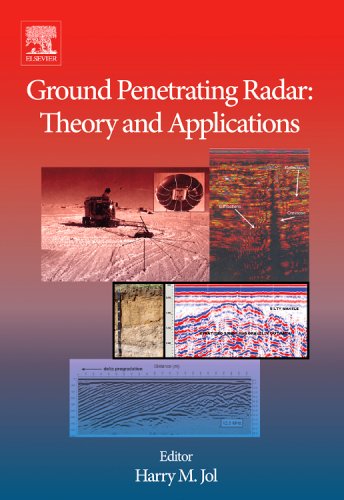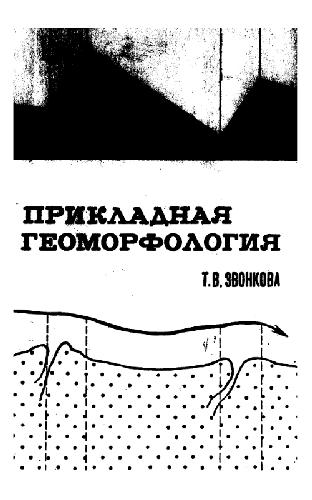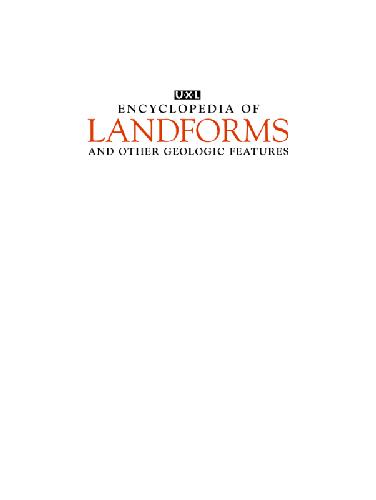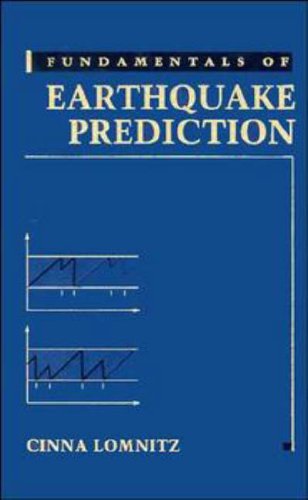Harry M. Jol0444533486, 9780444533487
Table of contents :
Cover Page……Page 1
Copyright Page……Page 2
Preface……Page 3
Contributors……Page 5
Electromagnetic Principles of Ground Penetrating Radar……Page 9
Electromagnetic Principles of Ground Penetrating Radar……Page 10
Introduction……Page 11
Overview……Page 12
Constitutive equations……Page 13
Material properties……Page 14
Wave Nature of Electromagnetic Fields……Page 15
Wave properties……Page 17
Ground penetrating radar source near an interface……Page 18
Reflection, refraction, and transmission at interfaces……Page 20
Resolution and zone of influence……Page 21
Scattering attenuation……Page 23
Signal Measurement……Page 24
Time ranges and bandwidth……Page 25
Center frequency……Page 26
Characterizing system response……Page 27
Recording dynamic range……Page 29
Antennas……Page 30
Antenna directivity……Page 31
Antenna shielding……Page 34
Sampling criteria……Page 36
Common-offset reflection survey……Page 37
Transillumination surveys……Page 38
Data Analysis and Interpretation……Page 40
Time gain……Page 41
Deconvolution……Page 42
Topographic correction……Page 43
Summary……Page 44
References……Page 45
GPR CONFERENCE REFERENCES……Page 47
Introduction and Background……Page 48
Methodology – Types of Ground Penetrating Radar……Page 49
Swept frequency-modulated continuous wave……Page 50
Gated, stepped frequency-modulated continuous wave……Page 51
Dynamic range……Page 52
Range resolution……Page 53
Unambiguous range……Page 54
General Design Criteria for Ground Penetrating Radar……Page 55
Theory of operation: Impulse radar……Page 56
Real-time sampling – complete waveform receiver……Page 58
System design parameters: impulse radar……Page 59
Transmitter……Page 60
Stepped-frequency technique – synthesized pulse……Page 61
Frequency modulation……Page 64
Gating……Page 65
System design parameters: stepped-frequency radar……Page 67
Frequency-synthesized source……Page 68
Transmitter and receiver……Page 69
References……Page 70
Introduction……Page 73
Energy transfer from antennas……Page 76
Gain……Page 78
Coupling energy into the ground……Page 79
Bandwidth……Page 80
Polarisation – linear, elliptical, circular……Page 81
Antenna patterns……Page 82
Time sidelobes and ring-down……Page 83
Antenna footprint……Page 84
Introduction……Page 86
Coupling into a dielectric……Page 87
Time domain antennas……Page 89
Dipole……Page 90
Loaded antennas……Page 91
Bow-tie antennas……Page 94
TEM horn antennas……Page 96
Frequency domain antennas……Page 98
Vivaldi……Page 100
Horn antennas……Page 101
Array antennas……Page 102
Definitions……Page 107
References……Page 109
Further Reading……Page 110
Soils, Peatlands, and Biomonitoring……Page 114
Introduction……Page 115
Soil properties that affect the performance of ground penetrating radar……Page 116
Soil suitability maps for ground penetrating radar……Page 117
Ground penetrating data and soil surveys……Page 121
Uses of ground penetrating radar in organic soils and peatlands……Page 126
Biomonitoring……Page 129
References……Page 133
Introduction……Page 139
Petrophysics……Page 142
Hydrostratigraphic Characterization……Page 145
Distribution/Zonation of Flow and Transport Parameters……Page 150
Moisture Content Estimation……Page 153
Monitoring Dynamic Hydrological Processes……Page 160
Recharge/moisture content in the vadose zone……Page 161
Water table detection/monitoring……Page 164
Solute transport in fractures……Page 165
Studies of the hyporheic corridor……Page 167
Carbon gas emissions from soils……Page 168
Conclusions……Page 173
References……Page 174
Introduction……Page 183
Contaminant Types……Page 184
Electrical properties of NAPLs……Page 185
Electrical properties of soil and rock with NAPL contamination……Page 186
Inorganics……Page 189
DNAPL……Page 190
Inorganics……Page 191
GPR Methodology……Page 192
Data differencing……Page 193
Quantitative estimates of NAPL……Page 194
Case Studies……Page 195
Controlled DNAPL injection……Page 196
Accidental spill sites……Page 198
Leachate and waste disposal site characterization……Page 200
References……Page 201
Terms for Glossary……Page 205
Ground Penetrating Radar in Aeolian Dune Sands……Page 206
Ground Penetrating Radar in Aeolian Dune Sands……Page 207
Sand Dunes……Page 208
Step size……Page 211
Vertical resolution……Page 212
Topography……Page 213
Topographic surveys……Page 214
Imaging Sedimentary Structures and Dune Stratigraphy……Page 215
Radar Facies……Page 216
Radar Stratigraphy and Bounding Surfaces……Page 217
Superposition surfaces……Page 219
Interdune surfaces……Page 220
Stratigraphic Analysis……Page 222
Three-Dimensional Images……Page 224
Environmental noise……Page 225
Multiples……Page 227
References……Page 228
Introduction……Page 232
Methodology……Page 234
Ground Penetrating Radar Strengths in Coastal Environments……Page 236
Ground Penetrating Radar Limitations in Coastal Environments……Page 237
Examples of Ground Penetrating Radar Images from Coastal Environments……Page 238
Record of coastal progradation……Page 239
Signatures of coastal erosion……Page 240
Coastal Paleochannels……Page 241
Ground penetrating radar signal response to lithological anomalies in coastal dunes……Page 243
Deltas……Page 245
Reservoir characterization – hydrocarbon and hydrogeology……Page 246
Summary……Page 247
References……Page 248
Introduction……Page 256
Antarctica……Page 258
Alpine glaciers: Dry Valleys……Page 260
Polar firn: West Antarctica……Page 262
Englacial stratigraphy: West Antarctica……Page 266
Ice shelf: McMurdo Sound……Page 268
Crevasses: Ross Ice Shelf……Page 271
Alaska……Page 274
Temperate valley glacier: Matanuska Glacier……Page 275
Temperate valley glacier: Gulkana Glacier……Page 277
Temperate firn: Bagley Ice Field, Alaska……Page 279
Temperate hydrology: Black Rapids Glacier……Page 280
Summary……Page 283
References……Page 284
NDT Transportation……Page 288
NDT Transportation……Page 289
Introduction……Page 290
General……Page 291
Ground-coupled systems……Page 292
Antenna and GPR system testing……Page 293
Accessory equipment……Page 294
General……Page 295
Data collection setups and files……Page 297
Positioning……Page 298
General……Page 299
GPR data preprocessing……Page 300
Air-coupled antenna data processing……Page 301
Ground-coupled data processing……Page 302
Determining dielectric values or signal velocities……Page 304
Interpretation of structures and other objects……Page 305
GPR and FWD……Page 307
Profilometer data……Page 308
GPS, digital video and photos……Page 309
Subgrade quality and presence of bedrock……Page 310
Soil moisture and frost susceptibility……Page 311
Other subgrade applications……Page 312
Unbound pavement structures……Page 313
Defect in bituminous pavements……Page 314
Concrete pavements……Page 316
GPR in QC/QA……Page 317
General……Page 319
Bridge deck surveys……Page 320
Other bridge applications……Page 322
General……Page 323
Data collection from railway structures……Page 324
Ballast surveys……Page 325
Subgrade surveys, site investigations……Page 326
Airfields……Page 327
Summary and Recommendations……Page 329
References……Page 330
Introduction……Page 339
Electromagnetic Analysis……Page 340
System Design……Page 349
GPR Data Processing for Landmine/UXO Detection and Classification……Page 356
Fusion with Other Sensors……Page 363
Overall Performance of GPR as an UXO/Landmine Sensor……Page 366
Conclusion……Page 367
References……Page 368
Introduction……Page 373
Field Methods for Archaeological Acquisition……Page 375
Imaging Techniques for Archaeology……Page 376
Depth Determination……Page 378
Case Histories……Page 379
Case History No. 1: The Forum Novum, Tiber Valley, Italy……Page 380
Case History No. 2: The Villa of Emperor Trajanus of Rome, Italy……Page 382
Case History No. 3: Wroxeter Roman Town, England……Page 388
Case History No. 4: Saitobaru Burial Mound No. 100, Japan……Page 389
Case History No. 5: Saitobaru Burial Mound No. 111, Japan……Page 392
Case History No. 6: Monks Mound, Cahokia, Illinois……Page 395
Case History No. 7: Jena Choctaw Tribal Cemetery, Louisiana……Page 396
Case History No. 8: Glaumbaer Viking Age, Iceland……Page 399
References……Page 401







Reviews
There are no reviews yet.